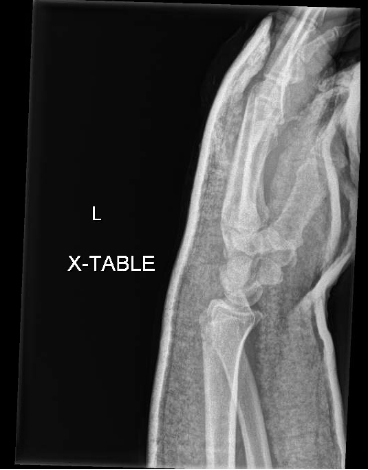Lunate Dislocation
CASE
A 51-year-old male with no past medical history presents to the ED with wrist pain after a fall. Earlier today, he lost his balance and fell down 12 stairs, landing on his outstretched hand. He has had increasing swelling of the radial aspect of his left wrist as well as extreme pain with movement. He did not strike his head or lose consciousness, and reports no other injuries.
On exam, he has swelling and deformity of the left wrist with decreased range of motion secondary to pain and moderate tenderness to palpation. Sensation in the radial, median and ulnar distributions are all normal without paresthesias and the radial pulse is intact. The forearm compartments are soft and the skin is intact.
DISCUSSION
There are a number of wrist injuries that can result from a fall on an outstretched hand (FOOSH). These include:
Colles fracture: Fracture of the distal radius, often presenting with an obvious “dinner fork deformity” (dorsal displacement of the distal radius). It is crucial to assess the neurovascular status of the distal component.
Figure 1. Colles Fracture
Scaphoid fracture: Presents with radial-sided wrist pain and tenderness upon palpation of the “anatomical snuff box” (radial fossa). Osteonecrosis occurs in 13-50% of patients regardless of treatment due to slow blood flow to this bone.
Figure 2. Anatomical Snuffbox
Hook of hamate fracture: Presents with numbness or paresthesias in the fourth and fifth digits after FOOSH injury. The hook of the hamate is close in proximity to the ulnar nerve, which can be damaged in this type of injury.
CASE CONTINUED
To determine the cause of this patient’s wrist pain and swelling, an urgent X-ray of the wrist is ordered at this time.
Figure 3. Lunate Dislocation
X-ray of the wrist shows volar dislocation of the lunate, which is separation of the lunate from both the capitate and the radius.
DISCUSSION CONTINUED
This injury typically occurs after high energy trauma to a dorsiflexed wrist, and is much less common than the less severe perilunate dislocation (disruption of the relationship between capitate and lunate).
This abnormality is often overlooked on an AP radiograph, but can be recognized as a disruption to the smooth tracing of the proximal surfaces of the hamate and capitate, with the lunate overlapping the capitate creating a triangular appearance. On a lateral radiograph it is seen as the volar displacement of the lunate with a “spilled teacup” appearance, with the lunate no longer aligned with the radius.
This diagnosis requires prompt management, because a delay in treatment can result in permanent median nerve injury or avascular necrosis of the scaphoid or lunate, resulting in deterioration of the wrist joint. Initial closed reduction and splinting can be performed in the emergency department to relieve median nerve compression and prevent further cartilage damage. Patients should be evaluated by the hand surgery team within 72 hours and a splint should stay on until that time. These injuries typically require surgical intervention to stabilize the wrist and prevent long-term damage. Even with proper treatment, there is a risk of future instability and degenerative arthritis.
In the case of diagnosis at a community ED, the patient must be transferred to a center where urgent orthopedic evaluation is possible. This patient was placed in a temporary sugar tong splint and transferred to a level 1 trauma center, where the dislocation was reduced by the plastic surgery team and the patient was admitted for subsequent open reduction and internal fixation of the lunate.
Author: Katherine Barry is a fourth year medical student at the Warren Alpert Medical School of Brown University.
Faculty Reviewer: Kristina McAteer, MD is an attending physician at Rhode Island Hospital and Newport Hospital.
REFERENCES
deWeber, Kevin. “Lunate Fractures and Perilunate Injuries.” UptoDate, www.uptodate.com/contents/lunate-fractures-and-perilunate-injuries?search=lunate+dislocation§ionRank=2&usage_type=default&anchor=H10&source=machineLearning&selectedTitle=2~6&display_rank=2#H6.
Dixon, Andrew, and Andrew Murphy. “Lunate Dislocation: Radiology Reference Article.” Radiopaedia Blog RSS, radiopaedia.org/articles/lunate-dislocation?lang=us.
Perilunate and Lunate Dislocations By Danielle Campagne, et al. “Perilunate and Lunate Dislocations - Injuries; Poisoning.” Merck Manuals Professional Edition, Merck Manuals, www.merckmanuals.com/professional/injuries-poisoning/dislocations/perilunate-and-lunate-dislocations.
StuWilli. “Injuries to the Upper Extremity Due to Falls on Outstretched Hands (FOOSH) .” Journal of Urgent Care Medicine, 13 July 2020, www.jucm.com/injuries-upper-extremity-due-falls-outstretched-hands-foosh/.
Sociedad Mexicana De Podología Médica, somepomed.org/articulos/contents/mobipreview.htm?24%2F12%2F24777.
“The Anatomical Snuffbox.” TeachMeAnatomy, teachmeanatomy.info/upper-limb/areas/anatomical-snuffbox/.



